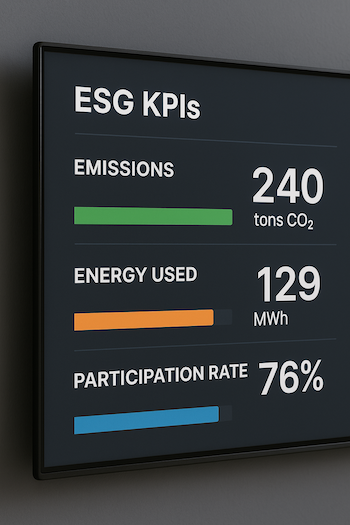Table of Contents
Introduction
In today’s corporate landscape, setting ambitious sustainability goals is no longer enough. Stakeholders—from regulators to investors to employees—expect companies to demonstrate real progress backed by data. But here’s the catch: even the best ESG strategy fails without employee accountability.
So how do you move from vision to action? It starts with defining Sustainability KPIs that not only track impact but also empower employees to own their role in creating a sustainable business.
At DoGood, we’ve worked with companies like RIU, BBVA, and Accenture to translate ESG strategy into daily behaviors, measurable actions, and purpose-driven culture. In this article, we’ll show you how to build KPIs that drive both engagement and results.
Why Sustainability KPIs Matter More Than Ever
Sustainability KPIs are more than metrics—they’re cultural signals. When well-designed, they:
Make sustainability visible and actionable
Show employees how they can contribute individually
Reinforce the company’s commitment to ESG values
Align with frameworks like CSRD, SFDR, and GRI
Create a feedback loop between employees and ESG leaders
According to EY, 85% of employees don’t know their company’s ESG objectives. That disconnect is costing companies both credibility and progress.
From Strategy to Action: The Accountability Gap
Most ESG strategies are developed at the top—and stay there. What’s missing?
- Clear ownership at every level.
- KPIs that include behavioral and cultural metrics.
- Systems for feedback, recognition, and adaptation.
Here’s the truth: without internal activation, your ESG strategy will stall. You need tools and KPIs that empower employees to act—and feel responsible.
The 4 Levels of Sustainability KPIs
To embed sustainability into your culture, your KPIs should operate on four interconnected levels:
1. Organizational KPIs (Strategic Alignment)
GHG emissions reduction
Circular economy adoption rate
ESG disclosure compliance (e.g., CSRD, TCFD)
% of supply chain ESG-audited
Owned by: Sustainability and Compliance leaders
Challenge: Often invisible to employees

2. Team/Department KPIs (Shared Responsibility)
Energy savings in office operations
Green procurement targets
DEI participation rate
% of team involved in ESG initiatives
Owned by: Department heads + ESG champions
Tool: Dashboards that track participation per team
3. Employee Engagement KPIs (Cultural Activation)

- % of employees completing ESG training
Number of sustainable actions per user
Feedback scores on ESG initiatives
Participation in monthly sustainability challenges
Owned by: HR, Culture, and ESG engagement teams
Tool: Platforms like DoGood to gamify and measure participation
4. Purpose & Impact KPIs (Social Value Creation)
Volunteer hours logged
Funds raised for ESG-aligned causes
Ideas submitted for sustainable innovation
Community impact score
Owned by: All employees
Insight: Turn values into stories, not just stats
How to Make Employees Accountable: A Step-by-Step Guide
Step 1: Set Meaningful, Relevant KPIs
Don’t expect employees to care about “scope 3 emissions” unless you connect it to their day-to-day.
- Translate complex ESG goals into human-scale actions
- Align KPIs with values, not just numbers
- Prioritize clarity over complexity
Example: Instead of “reduce waste by 30%”, try “complete the weekly waste audit challenge” or “bring a reusable item to work twice a week.”
Step 2: Create Systems for Engagement
KPI ownership requires visibility and motivation.
- Use digital platforms to gamify progress
- Launch challenges tied to company-wide goals
- Celebrate top contributors and teams
- Connect ESG to performance reviews or internal recognition
With DoGood, companies introduce custom sustainability challenges by topic (Mobility, DEI, Cybersecurity) and track employee progress via points, impact reports and dashboards.
Step 3: Give Feedback and Report Impact
Accountability thrives on feedback loops.
- Share progress transparently across the company
- Use dashboards to show how individual actions contribute to ESG KPIs
- Ask for feedback: what’s working? what’s not?
Insight: 75% of employees feel more connected to their company’s mission when they see how their actions make an impact (DoGood Benchmark Report 2024).
Step 4: Embed Accountability in Culture
Make it cultural, not just procedural.
- Link KPIs to onboarding and talent development
- Use internal communications to spotlight ESG stories
- Train managers to coach teams on sustainable behaviors
This isn’t about micromanagement. It’s about building a movement of accountability around shared ESG goals.
How DoGood Makes It Happen
At DoGood, we help companies:
- Co-design KPI frameworks linked to their ESG strategy
- Activate employees with personalized challenges
- Track engagement with real-time dashboards
- Deliver measurable behavioral and cultural impact

From blue-collar operations to corporate HQs, we tailor experiences that make sustainability part of every employee’s journey.
Conclusion: From KPIs to Culture
Accountability isn’t about control—it’s about clarity and connection. When employees know what’s expected of them and feel empowered to act, sustainability becomes part of your culture, not just your reports.
Want to turn your ESG goals into collective action?
👉 Book a demo with DoGood and discover how we help companies like yours bring their sustainability strategy to life—one KPI at a time.
